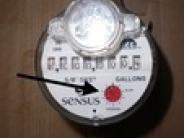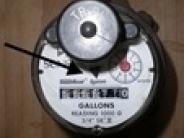How to Check for a Water Leak
Finding water leaks can save you water, which means saving money on your water bill. Follow these easy steps to determine if you have a leak in a domestic or sprinkler irrigation system.
Step 1. Turn all water-using appliances off so that no water is being used. This means turning off all water inside and outside the house including showers, sinks, washing machines and any appliance that uses water. If you have a sprinkler irrigation system, turn off the controller and manually shut off the two valves at the double check valve assembly (DCVA) to isolate the irrigation system.
Step 2. Locate your water meter. Your water meter will look similar to one of the water meters below. (NOTE: If you are unable to locate your water meter you may have a pit meter that will have to be accessed and read by the DPW. Please call the office to coordinate a meter read.)
Your meter will have a triangular black disc or a red circle that is commonly called a "leak indicator". If it is spinning, you have a leak. If there is no indicator on the meter and the actual meter dial hand is moving, water is running somewhere in your system and you have a leak - continue to step 3.
If the hand is not moving, note the position of the hand and wait 10 minutes. Check the meter again, if it has moved, you have a slow leak - continue to step 3. If not, you do not have a leak.
Step 3. If the leak indicator or dial hand is moving, water is flowing. That means you have a leak somewhere in the house. Check the toilets, washing machines, faucets, water softeners, etc., for any leaks. (You may have to call a plumber if you are unable to locate the leak.)
Step 4. To check a toilet for a leak, flush the toilet and while the reservoir is still filling, add 2 or 3 drops of food coloring to the water in the reservoir. Wait 15-30 minutes. If the bowl changes color, there is a leak and the flapper valve needs to be replaced.



